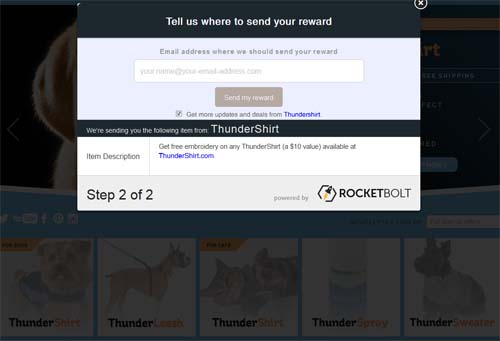Ubiquitous Popunders
“Popunders” are annoying messages you get after clicking on a website like the J. Crew example above. Popunders ask visitors to join an email list in exchange for special benefits. Couple of weeks ago we reviewed holiday design (Why Is Holiday Website Design So Bad This Year) for 37 leading online retailers. Almost every website in our study uses a popunder.
Last week we also noted our confusion about Rocketbolt after Triangle Startup Factory’s Fall 2013 Showcase. After lunch yesterday with Rocketbolt’s Biz Dev Manager Andy Roth we understand and like Rocketbolt’s value proposition of creating a better popunder.
Q: Why are popunders so ubiquitous?
A: Popunders work, and email marketing has never been more important (or difficult)!
Like all Internet marketing tactics popunders work best when your website is the only one popping your message under your customers’ visits. Now that most websites use popunder efficacy will decline UNLESS your popunder is different. RocketBolt.com creates a “popunder Quid pro quo conversation” that feels different from the J. Crew “Give Us Your Email To Learn About Fashion First” “blast” offer (any visitor sees the same offer so it is a “blast”).
Rocketbolt.com creates a three step “Quid pro quo conversation”:
- Ask for a Facebook LIKE, tie the LIKE to a Call-To-Action offer or LIKE us, get X (the ASK & can easily grouped by persona).
- Secure Facebook LIKE (the GIVE).
- Ask for email to deliver the reward (the Quid pro quo).
These images illustrate RocketBolt’s “conversational Quid pro quo popunder” approach on Thundershirt.com a very successful Durham based comfort garment for dogs:

Click on the box and you are asked to complete the Facebook like.

Complete the like and you are asked where to send your offer:

Why Rocketbolt’s Conversatonal Popunder Is Better
We don’t have a dog in this hunt (so to speak). Atlantic BT didn’t create Rocketbolt’s website and I just paid for lunch with Andy. We like the idea of a “conversational Quid pro quo popunder” despite the clicks. We don’t like creating Internet marketing that is the same as everyone. Popunders asking for email subscription are beyond ubiquitous, so Rocketbolt’s new idea should get traction with ecommerce and B2B teams.
When I was a Director of Ecommerce email marketing was 10 full margin points more profitable than organic SEO (our #2 channel). The email marketing tsunami of the last three years was therefore predictable. Mobile is an email marketing game changer. Mobile makes curating email easy, fast and painless. We’ve had email marketing customers say lists are larger but open rates are down – something we attribute to mobile curation. Email marketing has to earn its way through the mobile gatekeeping to buyers’ pads, laptops and desktops (where most purchases continue to be made).
Every ecommerce team knows their email subscriber list is critical to successful diversified Internet marketing. Diversified Internet marketing is important because channels can go south fast. If all of your eggs are in PPC and performance suffers your profits suffer. If your Internet marketing is diversified, much like a stock portfolio, profits are spread across channels. Sales should come from email marketing, cause marketing, content and social marketing, video marketing, contests and gamificaiton and traditional market making (print, tv). By diversifying across as many channels as possible Internet marketers hedge their investments and assure growth even if profits from a single channel dive.
Email marketing is one of the most profitable Internet marketing channels and marketing teams don’t need to pay Google to mail their list. At this time of year we were mailing daily. We stopped “batching and blasting” or sending the same message to everyone on our list because it felt like spam. Email lists and message creative should be organized into personas and segments. Personas and segments are CSFs (Critical Success Factors) to successful “life cycle email marketing”.
Life cycle email marketing knows what offers “new to file” customers should receive and how those offers are different from strong LTV (Lifetime Value) sale shoppers. Emailing daily needs relevant messages. Personas are customer archetypes that group customers by behavior, psychographics and demographics. Personas are key to creating relevant email marketing.
Segments are your financial overlay. Your sales history may show your “Mary Overwhelmed Mother” persona is highly profitable but LTV is low so money to the bank isn’t as good as “Dan Deal Shopper” whose purchases are margin challenged but dollars to the bank are better because Dan buys more often and in response to specific stimulus.
Profits are important but not the only email marketing metric an ecommerce team must create, know and use.
Rocketbolt Creates Email Marketing Groups
“New to file” customers need different offers, content and email marketing schedules than a “sale only empty nester” persona or a “overwhelmed working moms” persona or a “retired businessman / father” persona. Creating different “popunder conversations” to appeal to different segments is one of RocketBolt’s strengths.
Thundershirt can create offers for little dogs or big dogs, puppies or older dogs and family dogs or dogs who are alone until their pack leader makes it home from work. RocketBolt’s assist in creating personas and segments is powerful since you know a lot about “new to file” customers based on Rocketbolt offers accepted or passed.
Best book I’ve read about creating personas and segments is Managing Content Marketing by Robert Rose.

Rocketbolt’s conversational popunder is a cool way to create “sophisticated ad serving” even if getting deep into the data might require an Adzerk-like approach.
By changing the nature of the conversation from the single goal, “We want your email” to a “giving conversation” where Rocketbolt helps Thundershirt offer something of value in exchange for something of value Rocketbolt’s tool creates a better “Quid pro quo” than J Crew’s empty promise of seeing style news “before everyone else” and every Rocketbolt offer produces a world of data.
We like Robcketbolt’s Quid pro quo conversational popunder where customers share email to get a specific reward. Rocketbolt helps build a file of people who’ve responded to an offer. At lunch with Andy Roth from Rocketbolt I predicted they will see Lifetime Value (LTV) is higher for people added with Rocketbolt’s conversational Quid pro quo popunder. I base that assumption on three things:
- Syncapse pegs value of a Facebook like at $174, up 28%.
- Multi-channel supporters are typically worth more.
- Even if wrong Rocketbolt’s costs are so low its moot.
Rocketbolt needs a partner like J. Crew, a partner who could easily test existing popunder performance vs. Rocketbolt’s “conversational Quid pro quo popunders”. In the meantime, Rocketbolt’s fees are so low I would have added their “conversational popunder” into rotation. As a Director of Ecommerce running a website with over $6M in annual sales when a tool looked beneficial and the cost was so low any benefit pays for the tool adding it into rotation was a no brainer.
Our ecommerce website code would be in “lockdown” starting right after Halloween and lasting until January, but Rocketbolt’s single line of Javascript shouldn’t be highly disruptive or hard to implement once code came out of holiday lockdown in January. If your IT team is anything like my old IT gatekeepers they don’t like adding more JavaScript into your websites “head”. Most sites already have three to ten different JavaScript “widgets” firing out of the code in their “head”.
Every line of Javascript (JS) can potentially create collisions with JS already firing, so be sure to test. Test across every page that includes a JS widget. If you have a widget firing in your “terms” page, for example, check the terms page after you add Rocketbolt. JS conflicts are so conditional they can be hard to “see” in a testing sandbox. Sometimes we flipped the switch and all the lights went out. Other times we flipped the switch and everything looked fine until just the right sequence caused a crash. Test and then test some more.
If LTV from Rocketbolt’s conversational popunder proves more profitable then I would eliminate existing popunders in favor of Rocketbolt’s conversational approach. That may seem radical, but the popunder wars are waging. I preferred our website to lead not follow. Popunders work, but popunder efficacy is under attack due to their success.
I would add Rocketbolt in the rotation to see how powerful the tool’s ability to profile and segment can become. Add a little sophisticated ad serving along with well tested email life cycle marketing and I bet you get more highly qualified leads into your email marketing from Rocketbolt’s “conversational popunders” faster than blasting the same popunder offer to everyone.
B2B websites don’t use popunders as much as B2C, but email marketing is no less important. We like Rocketbolt’s conversational Quid pro quo popunder for B2B. B2B is about the quality of your conversation and the relevance of your content. If someone visits your “gamificaiton” content using Rocketbolt to popunder an offer for a free white paper feels more helpful than intrusive. AND talk about knowing something as a “new to file” customer comes into your list! If you are spending $30K or more on an inbound marketing tool and/or CRM adding Rocketbolt is a no brainer.









